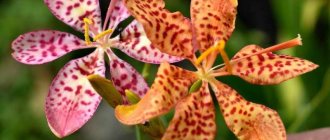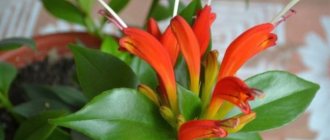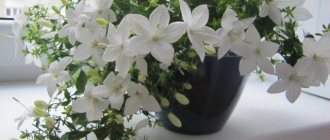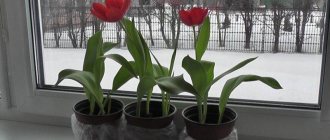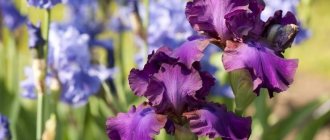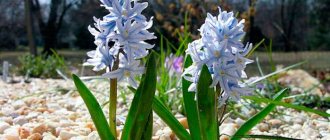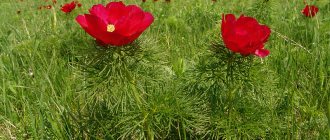Erica herbaceous planting and care. Caring for Erica at home
Growing as a perennial requires experimentation and intuition, as the plant often behaves unpredictably. But for flower growers and gardeners who love a challenge, Erica has plenty of treats in store.
Lighting for Erica
It’s very easy to choose lighting for Erica. If the plants are located in living rooms or in any rooms in the house, then the plants need to be provided with a sunny place (if possible, then with protection from direct sunlight at midday in the summer), with the maximum possible brightness of lighting. If Erica is placed on a balcony, loggia, or taken out into the open air in the summer, then the place for this crop should be semi-shaded. Bright lighting quickly dries out the shoots and the plant becomes much more vulnerable to pests and diseases.
Comfortable temperature conditions
Selecting a comfortable temperature for Erica is considered a rather difficult task. For flowering, this plant is suitable for air temperatures up to 15 degrees Celsius, while Erica does well in warm rooms, provided there is access to air and good lighting: higher temperatures are easily compensated by increased air humidity. The longest flowering of this shrub can be observed at a temperature of 7-8 degrees on a cool loggia or balcony; at temperatures up to 15 degrees, flowering is reduced by several weeks. In the summer, during the dormant period, this beauty feels great in almost any, even hot, conditions, but with one “but”: it is not sensitive to temperatures only when exposed to the open air. When kept indoors, Erica still prefers coolness or the maximum possible moderate temperature (18-20 degrees). At the end of autumn, to stimulate flowering, Erica should be placed in a cool place (5-10 degrees); it can also begin outside when the temperature drops, but you still need to monitor the weather and avoid even “zero” marks.
Where is the best place to plant Erica?
When choosing a place for Erica, it is necessary to take into account the fact that in natural conditions the shrub grows on well-drained and breathable soil, which means that similar conditions must be ensured in home cultivation, because stagnation of water in the root system can lead to flower diseases.
Read also: Chinese lobo radish: growing features
As for the location, the plant does not tolerate direct sunlight, therefore, it is better to choose a well-lit but cool area.
Based on this, Erica will feel great on an eastern or east-west window.
The soil should be acidic, with a pH level of 3-4. The best soil for Erica is soil consisting of turf, peat and sand.
Eric's plant is a shelter for the winter. Description of Eric's plant
Erica is a beautiful evergreen shrub, small in size, with narrow, needle-shaped leaves. Erica can be seen blooming in summer and winter. If the place of its growth is cold regions, then flowering occurs in spring and autumn. Since dried flowers do not fall off for a very long time, it seems that flowering lasts for six months.
The name Erica itself has its roots in Ancient Greece and means “to break” (ereiko). Ancient people believed that if you infuse Erica leaves in a special way and drink the liquid, you can break up kidney stones, and then they will come out on their own. Some people generalize Erica with heather. But botanists say that this is not true, although it can be quite difficult to distinguish common heather from Erica. To do this, you need to have special knowledge in the field of crop production.
Erica can grow as a subshrub, shrub or tree with leaves similar to pine needles. When flowering, Erica is covered with a large number of small white or pink flowers. The flowers form dense clusters and resemble drooping bells.
There is practically no place where Erica cannot be found: it grows in Europe, Turkey, and Africa, where there is a temperate climate. But most often it can be found in the Cape Province (South Africa). Anyone who has been to Scotland could not help but see massive thickets of this plant on mountain slopes, vast wastelands and peat bogs.
Varieties
There are more than 600 species in the genus Erica. They have significant differences among themselves: in the size and shape of the bush, the shade of flowers and leaves, unpretentiousness to the environment (some prefer swampy wastelands, while others prefer dry heather). On some bushes of this plant, the color of the leaves changes in winter. For the most part, Erica is a winter-flowering shrub, and only a few of them produce flowers on warm summer days. Let's take a more specific look at the most common varieties of this beautiful shrub.
- Herbal Erica (Carnea Erica). It is also called “ruddy”. This is an evergreen shrub with a lush crown. It reaches a height of up to half a meter. Some peoples also call it “winter heather.” When Erica is planted in southern latitudes, it can throw out flowers in winter, so the preferred territory for it is central Russia. This plant alone includes about 200 varieties. You can grow it by analogy with a ground cover, because as soon as it grows, it will cover the ground with a living carpet. It is customary to decorate alpine hills or heather gardens with Erica. The branches of this plant extend in different directions, and the shoots are bare, only covered with dark gray bark. The leaves are painted in a bright green shade, have a linear elongated shape, grow in fours, up to one centimeter long. The leaves that grow from the bottom of the bush and are the oldest ones acquire a reddish color in the fall. When flowering occurs, the bush is decorated with pink and red buds, sometimes you can see a white tint. The flowers look like drooping bells. The buds are located in the axils of the leaf blades, from two to four pieces, which are then transformed into racemes-inflorescences. Erica's flowering period is from mid-spring to mid-summer, depending on the planting location. As for the southern regions, you can admire the flowers as early as March.
Popular types
Erica is one of the ornamental plants that are one of the first to produce greenery and become covered with flowers, signaling the arrival of spring. Most varieties are characterized by abundant and long flowering, which occurs twice a year:
- from the last week of February to April;
- from June to October.
Numerous representatives of the genus Erica are bushes with a height of 20 to 150 centimeters. They differ from each other in the color of leaves and inflorescences, structure and shape, as well as requirements for living conditions. There are varietal varieties with golden stems.
Despite the wide variety of species and hybrid forms, gardeners prefer to grow four main varieties of Erica, which can be kept both on site and at home.
Darlenskaya (Darleyensis)
This species was bred by English breeders in 1905. It is a hybrid form obtained by crossing the Erica erigena and Erica carnea varieties. From the first, the plant inherited a large number of flowers, and from the second, a long flowering period. The peculiarity of this variety is its rapid development and active growth.
Darlen Erica grows in the form of a prostrate shrub 25-50 centimeters high; wild specimens have stems 70-90 centimeters long. The bushes have linear leaves, colored dark green. Snow-white, lilac-pink or dark crimson flowers form one-sided inflorescences.
There are a total of 25 varieties of this variety. The following varieties are popular in European countries, blooming from February to May:
- Janie Porter - lilac-pink blooms;
- Arthur Johnson - plants up to 70 centimeters high with purple flowers;
- Silberschmelz - white inflorescences;
- Derley Dale - small bushes 40 centimeters high, covered with numerous light-colored flowers (pink and lilac);
- Erecta - purple-pink inflorescences.
These forms grow well in Europe, and in Russia they prefer to grow the White Perfection and Kramers Roth varieties. However, they are not winter-hardy and are afraid of cold weather, so they need to be covered for the winter.
Herbaceous or ruddy
Erica herbaceous or ruddy grows in the center and south of Europe. It is a shrub 30−65 centimeters high with a branched crown with a diameter of 15−40 centimeters. The needle-shaped leaves are 4-8 millimeters long, have a glossy surface and are painted bright green. Drooping, bell-shaped flowers form small brushes (2-5 centimeters), which are hidden in the axils of the leaves. Usually their color varies from red to pink, less often white.
The beginning of flowering depends on the region: in the southern regions, Erica blooms earlier, sometimes as early as March. But the further north the growing area is, the later this process begins; for example, in Russia it occurs at the end of April-beginning of May.
Alba is considered the most popular variety of ruddy Erica; with its help, many interesting hybrid forms have been developed.
Pink or Isabelle
Pink Erica is a small evergreen bush up to 15 centimeters in height with a voluminous crown up to 40 centimeters wide. Its narrow, needle-shaped leaves are dark green in color and turn brown in winter.
The flowering period occurs in April-May. At this time, the plant is decorated with a large number of small bell-shaped flowers with a light honey aroma. They are located at the tops of the stems and are colored white or light pink. Representatives of this species stand out very impressively against the background of snow thawed patches.
The root system is dense and located close to the soil surface. It is very sensitive to soil compaction. The plant prefers sunny places or partial shade. To root young shrubs, the soil in the flowerbed must be kept moist. Wild varieties often grow in wetlands, but cultivated flowers do not tolerate stagnant moisture in the soil.
The species is distinguished by abundant flowering and tolerates short droughts and frosts. Typically used to create group compositions with other representatives of the Heather family.
It is worth noting that pink Erica received an award from the English Royal Horticultural Society in 2002.
Graceful (gracilis)
Graceful Erica is a shrub up to 50 centimeters high. It has an uneven crown of light green color: the central branches are longer than the side ones. The linear leaves, similar to needles, are small in size, their length is only 4 millimeters.
The flowering of Erica graceful begins in October and ends closer to February. The elongated, oval-shaped flowers, depending on the variety, can have a variety of colors, most often white or pink, but there are varieties with bright red flowers. They gather at the tops of the stems in groups of 4 and form small inflorescences.
Such plants are propagated vegetatively , by rooting cuttings in nutritious and acidic soil. The shrub does not require special care; regular watering and good lighting are enough for it.
Most often, Erica gracilis is used as an indoor annual. It goes well with chrysanthemums and cyclamens. To create a beautiful composition, flower pots are often decorated with special pebbles or roots.
Erica herbaceous. Erica herbaceae blooms
Despite the winter, Erica herbaceae or ruddy is now blooming in the southern coastal parks - a real prima of rockeries.
botanical certificate
grass erica or ruddy (erica herbacea syn. e. carnea) - a low shrub from the heather family, 35-60 cm high. The leaves are shiny, bright green, needle-shaped, linear, short, 4-8 cm long, collected in 4. flowers bell-shaped, drooping, small, 2-7 cm long, purple-pink, rarely white; bloom in (February - March) - April-May. fruits are small, brownish boxes. grows slowly. homeland: central and southern Europe. A large number of varieties have been bred.
Decorative varieties:
- 'March Seedling' (light pink flowers, remontant);
Website photo used: photoshare.ru
- 'Myretoun Ruby' (dark pink flowers, red stamens);
- 'Vivellii' (flowers dark red, leaves blackish-dark green, bronze after winter).
Website photo used: www.ua.all.biz
Growing area
The European part of Russia (in the north to the middle zone) and neighboring countries.
cultivation features
Erica is relatively winter-hardy: it can withstand temperatures down to -15°C, it is photophilous, prefers neutral or slightly acidic soils, a location protected from winds, and is sensitive to dry air and soil. pruning after flowering. Resistant to pests.
Reproduction
By seeds, cuttings, dividing the bush, vegetative varieties.
application
Erica is good in rocky gardens, winter container compositions, in free-growing, beautifully flowering low borders, with trimming of the sides if necessary.
Vegetative propagation
It is better to propagate varieties and hybrids vegetatively, since when propagated by seed they may lose their varietal differences.
Propagation of Erica by cuttings
How to root cuttings of Erica photo
The process itself is not complicated. It is best to take cuttings in late summer. Fill a box or container with a sand-peat mixture, plant the cuttings, deepening them by 2-3 cm, and cover the top of the container with oilcloth or clear glass.
Erica cuttings photo
Air temperature and lighting are the same as when germinating seeds. They should remain in this position until spring, while raising the shelter for ventilation and periodically moistening the soil. Plant the rooted cuttings in separate pots or transplant them into open ground.
Reproduction of Erica by layering
In the spring, select a healthy shoot, bend it to the ground, after making a small hole near the bush. Secure with a pin or wire, cover with soil, and leave the top of the branch above the soil surface. Water and keep the soil slightly moist at all times, do not allow it to dry out. Next spring, the young plant can be separated from the mother bush and planted separately.
Erica planting and care. Erika
Erica is an evergreen shrub from the Heather family, numbering more than 500 different species in its genus. In their natural environment, plants can be found in the Mediterranean countries and South Africa.
Erica's high decorative qualities allow it to enjoy well-deserved respect among landscape designers. Erica flowers are often used for landscaping garden plots and decorating areas near buildings. It can be planted as a ground cover plant. Among the many species and varieties, there are bushes with different shades of leaves and flowers, with a variety of shapes and duration of flowering. The flowering plant goes well with other natural specimens and can feel harmonious in various compositional solutions. Excellent companion plants for evergreen shrubs would be rhododendrons, thujas, junipers and other representatives of conifers. One of the features of Erica is its wide palette of colors and shades - from delicate pastels to bright and rich pinks, purples, oranges and yellows.
Planting and caring for Erica in open ground
Location
It is recommended to choose for planting Erica an area that is sunny and illuminated for a long time during the day, protected from cold drafts and strong gusts of wind. The amount of sunlight determines the splendor and duration of flowering. Coniferous plantings or hedges made of deciduous crops can be used as protection from the wind. Small buildings can also serve as windbreaks. Light-loving and heat-loving Erica needs full warmth and lighting.
The soil
Most varieties and varieties of Erica prefer to grow in acidic soils, but some species develop well in neutral and slightly alkaline areas.
Watering
The moisture-loving plant must be watered regularly and generously, especially during hot summer days and dry periods. Watering should be done every day, especially in the first year after planting.
Mulching
In the evergreen Erica shrub, the root part is located close to the surface of the earth, so it needs additional protection in the form of a mulching layer of peat, rotted leaves or pine needles. Mulch will not only protect the roots, but will also prevent weeds from appearing, retain the necessary moisture in the soil and maintain the acidity level of the soil.
Growing Erica in winter
Erica has a low level of winter hardiness and poor resistance to cold, therefore, in regions with snowless and light snow winters, and even with very severe and prolonged frosts, heat-loving crops must be protected with the help of additional shelter. In the autumn, a thick mulching layer of peat is applied to the tree trunk circles near each bush, and the bush itself is covered with spruce branches in the form of a small hut in large quantities. In early spring, it is recommended to remove the cover to provide the crops with free access to sun and air and ensure full development.
Erica Reproduction
Erica propagates by seeds, cuttings, dividing the bush and layering.
Propagation by seeds
Seeds are sown in small planting containers with a moistened acidic soil mixture. It can consist of two parts of peat and one part each of coarse sand and coniferous soil. Sowing is superficial, without embedding. The box with seeds is covered with glass and kept in a warm, bright room with a temperature of about 20 degrees for about a month. When seedlings appear, it is very important to regularly moisten the soil and maintain high humidity. Grown seedlings dive into individual pots. Shortly before transplanting, the plants are hardened off and gradually accustomed to the open air.
Propagation by cuttings
For cuttings, apical cuttings 3-5 cm long are used. They are rooted for a month in a peat-sand substrate. Care consists of watering and fertilizing.
Reproduction by dividing the bush and layering
Reproduction by layering and dividing the bush is considered the most convenient and popular method. Young seedlings very quickly adapt to new growing conditions and a new location.
Diseases and pests
Possible diseases are powdery mildew, rust, various fungal and viral infections. Most often, the reason for their appearance lies in violation of the rules of plant care. Excess moisture in the soil and high humidity can lead to the appearance of gray rot. As a preventative measure, it is recommended to plant crops only in well-lit areas and avoid wet soils and close proximity to groundwater. Another reason for the onset of a fungal disease may be a winter shelter with high humidity and little air access. Control measures - treatment with fungicides. In case of a viral disease, when deformation of leaves and flowers occurs, it is better to remove the plant. Erica is practically not affected by pests.
Diseases and pests
- Gray rot - a gray coating appears on the branches, the plant sheds its leaves, and the branches partially die. The reason is high humidity.
- Powdery mildew - young branches dry out, and the plant becomes covered with a white-gray coating.
- Rust - red-brown spots form on the leaves.
When Erica is infected with gray rot, the branches die
Read also: How to grow an orchid indoors: types of orchids, suitable conditions for the flower, possible diseases
It is recommended to spray with antifungal fungicides such as Topaz or Fundazol, and in severe cases with Bordeaux mixture or a 1% solution of copper sulfate. After 5-10 days the treatment is repeated.
With a viral disease, flowers and shoots are deformed, the color of buds and foliage changes. Unfortunately, there is no treatment for this disease; the bushes will have to be dug up and burned.
When infested with scale insects and spider mites, a cotton-like coating and cobwebs appear on the bushes on the underside of the leaves, the foliage becomes deformed and turns yellow. It is recommended to treat with fugincides, for example, “Fitoverm” or “Aktellik”
Erica in landscape design. Flowering and types
At the end of winter and at the beginning of spring, the grassy or ruddy Erica (Eríca carnea) and Darley (Erica x darleyensis) bloom before everyone else. Flowering continues until the end of April. In the second half of June and until the end of August, the flowering time begins for the four-dimensional Erica (Erica tetralix), which prefers moist soil, and the ashy one (Erica cinerea). Erica vagans blooms in August-September with pink, white or cream flowers and can reach 75 cm in height.
Erica of Darley is a hybrid obtained at the beginning of the twentieth century by the English breeder Darley Dale by crossing Erica rouge. The popular variety "Kramers Rot" grows up to 50 cm in height and is one of the tallest varieties of this species. It grows quickly, creating large clumps.
Small, green, needle-like leaves are densely packed around the shoot. From late February to early March, as soon as the frosts have subsided and the snow has melted, ruby-red flowers appear on the bushes on raised stems. It blooms at relatively low temperatures, so flowering can last until May. Shelter is required for the winter.
Erica herbaceous is the most popular in culture. Very hardy, tolerant of most soils and the most frost tolerant of all cultivated species. It is a low-growing (10-25 cm) spreading shrub. Thanks to selection, more than 100 cultivated varieties and highly decorative hybrid forms were obtained. Some famous varieties: “Golden Star”, “Ice Princess”, “Myretoun Ruby”, “Natalie”, “Pink Spangle”, “Sunshine Ramble”, “Jenny Porter”, etc.
Erica ashy is cultivated in a wide range of colors. The height of the bushes is 15-60 cm. It overwinters under cover. Decorative varieties: “CD Eason”, “Pink Ice”, “Velvet Night”.
Growing Erica from seeds
Erica seeds photo
Generative (seed) propagation of Erica involves growing seedlings. Sowing seeds for seedlings in the spring. Prepare a soil mixture consisting of equal proportions of sand and peat.
- Fill a wide container with substrate and spread the seeds over the surface of the soil (they are small, so they should not be buried).
- Spray the crops with a fine spray and further moisten the soil in the same way so that the seeds do not “drown.”
- To create a greenhouse effect, cover the top of the box with the crops with glass or film, but lift the cover daily for ventilation.
- The lighting should be diffused, maintain the air temperature within 18-20 °C.
- Shoots will appear after 3-4 weeks, then the cover can be removed.
- When the sprouts reach a height of 8-10 cm, they must be planted in individual pots. They are not transplanted into open ground until next year.
Erica from seeds
During the warm season, seedlings can be taken out into the garden, and they should overwinter in a room with an air temperature of 10-12 °C.
Heather and Erica are different. These unusual shrubs
With the arrival of planting material from Polish and Dutch nurseries on our market, Russian gardeners were faced with the problem of choice. Many exotic plants appeared, previously unknown to a wide circle. These plants include heathers and ericas - extremely attractive small plants that are sold in spring and autumn in bloom. They look like small Christmas trees covered with small pink, purple or white flowers. Naturally, these plants immediately attracted the attention of gardeners, but, unfortunately, due to ignorance of agricultural technology, heathers and ericas do not always take root and grow well in our gardens. In fact, these are unusually attractive evergreens, reaching a height of 20-30 cm, and also having a long flowering period. As a rule, ericas bloom from early spring to early summer, and heathers bloom in late summer and go into winter with flowers. In addition, there are many varieties of heathers not only with different shapes and colors of flowers, but also with a variety of leaf colors - green, blue, yellow. In Western Europe, heather gardens have long been created, the advantages of which are obvious: they take up little space, consist mainly of evergreens, and are perfectly combined with stones, with other heather plants, such as rhododendrons, as well as with dwarf conifers. Heather gardens remain decorative throughout the season, are relatively unpretentious and easy to care for, and are not afraid of spring and autumn frosts. Their disadvantages include the cost and labor intensity of planting a garden and the need to cover it for the winter. These dwarf plants can perfectly complement a rock garden; they are good for decorating the banks of reservoirs, especially in combination with low coniferous shrubs and small bulbous ones. In Europe, heathers and ericas are widely used to create autumn and winter container compositions that decorate entrances to buildings and public places. They are especially often used for decoration at Christmas and New Year.
Features of Erica reproduction
Plant propagation can be done in the following ways:
Erica has very small seeds, which requires planting them indoors. To do this, you need to prepare plastic dishes or boxes with soil. Seeds are sown on the surface of the soil and are not covered with it. Before germination, the container with seeds is covered with glass or film. To ensure uniform and dense seed germination, it is necessary to select the correct soil.
To prepare the soil for planting Erica, you need to take one part each of coniferous and heather soil, sand and two parts of peat.
All soil components are thoroughly mixed. In order to get seedlings as quickly as possible, it is necessary to ensure a room temperature of 18-20 degrees. It is necessary to expect germination 30 days after planting the seeds. In the first week it is necessary to maintain high humidity. The plant must also be allowed to breathe periodically by opening the glass or film for 5-10 minutes.
In early spring, Erica can be propagated using apical cuttings:
To ensure that the cuttings are not damaged by diseases and do not wither, it is necessary to choose sufficiently hard cuttings. Their length should be within 2-3 centimeters. One third of the resulting cutting is immersed in the substrate.
A fairly effective method of plant propagation is dividing the bush. Initially, you need to dig up the old bush and divide it into several parts using a shovel. After planting parts of Erica, they need to be provided with timely care and weeding.
How to care
Care in open ground is based on the characteristics of the root system and nutritional needs at different stages of development.
Rules of care:
- Watering, loosening. Erica's roots are located at a shallow depth, so the plant quickly reacts to the lack and stagnation of moisture. The volume of watering depends on weather conditions. Loosen shallowly (10-12 cm) so as not to damage the roots.
- Feeding. After winter (April-May), dry mineral fertilizers (1.5-2 tbsp) are evenly distributed around the bush or watered with Kemira (2 g/1 l). Repeat feeding during budding and after flowering.
- Trimming. It is recommended to start pruning the bushes in the third year of life at the end of the flowering period - the shoots are shortened by ½-1/4 of the length, capturing the section of the stem just below the faded inflorescence. Pruning should not be carried out when new buds are forming and in late autumn.
- Preparing for winter. Before the onset of frost, the soil is mulched with peat, pine needles, and leaves. It is better to cover with coniferous branches, covering material that allows air to pass through. A cover made of spruce branches is multifunctional: it will save you from frost, condensation does not form under it (the plantings will not dry out), the pine needles that fall off in the spring will acidify the soil, and after use the branches can be chopped up and used as mulch.
Indoor “heathers” and their catchy beauty
Representatives of the Erica , which in nature are considered an invariable adornment of Scandinavian and British landscapes and are known mainly for the beauty of heathlands, are capable of surprising with their diversity. In the genus Eric, which is part of the family of the same name, there are more than 5 hundred species of plants. And although most of them remain wild plants, not introduced into garden culture, and the most famous Erics are garden plants, among the fifty thousand varieties there are also those species that will not refuse to be grown as a solo indoor plant. Genuine heathers (Calluna) are also grown indoors, but their maintenance requires a somewhat specific approach and the heather must be kept outdoors for most of the year.
Only two, but incomparable, types of Erica are grown as a houseplant - the herbaceous Erica (Erica herbacea), which has many magnificent varieties with different colors of inflorescences, and the less capricious, but also less spectacular Erica graceful (Erica gracilis). Both plants have many similarities in the type of flowering, size, and structure of the bushes. Moreover, almost all specimens presented on the modern market are hybrid varieties and their specific origin is sometimes not entirely easy to find out. And species plants are often confused with each other and sold under each other’s names. But you can still distinguish the herbal erica from the graceful one: the flowers of the first are colored only pink or red, while the flowers of the second are pink-lilac-purple. Everything else about the plants is very similar.
Today they are actively experimenting with other types of Eric in the West, trying to increase the range of these plants in indoor representation, but there is no talk of any noticeable “breakthrough” of other types. On sale today you can sometimes find Erica Wilmore (Erica x willmorei) with long, up to 2 cm bell-shaped flowers and Erica ventricosa growing in the form of a spherical bush, but they can be found rarely.
On a note. If you have specimens of other species of heather or heather in your garden, you can try to grow them as houseplants using the cutting method and not transferring the plants after rooting to open soil, but replanting them in a pot and adapting them to indoor conditions from an early age. These are great plants to experiment with.
Erica gracilis
Indoor Ericas are low-growing, very dense evergreen shrubs, the maximum height of which does not exceed half a meter, and is often limited to 40 cm. The diameter of the bushes always exceeds their height; in healthy and strong specimens it can reach 60 cm or more. These shrubs are constantly growing and, if grown as perennials, require increasingly larger containers or timely division. Eric's shoots are erect, densely branched, and form a dense crown. The leaves are typical of all heathers, strikingly small, rich medium, light or dark green, needle-shaped, densely spaced, which creates a unique texture of the crown.
But despite all the beauty of the greenery, the most noticeable feature of indoor erikas, like their garden counterparts, remains flowering. The apical racemes or spike-shaped, elongated inflorescences, consisting of bell-shaped, often almost spherical, miniature, brightly colored flowers, captivate with both their amazing palette of colors and the ability to produce inflorescences in unimaginably large quantities. Small flowers in dense inflorescences harmonize with small leaves. During flowering, the bushes are so abundantly strewn with inflorescences that they turn into a single color (and texture) spot.
Indoor Ericas traditionally bloom on the eve of winter or at the very beginning and show off their flowers until spring. At this time, the rich shades of the red spectrum - pink, lilac, purple flowers - are unusual and unique, not found in any other plants except heathers, or the white-flowering elegant varieties of Erica seem to be an outlandish vision and real strangers in the interiors.
To be successful in growing indoor Ericas as perennials, it is enough to keep them cool. This is the main and basic requirement of these plants, but far from the only one. Erica can hardly be called an easy-to-grow crop; this plant is suitable only for experienced gardeners who are ready for difficulties and can provide this heather beauty with special care and special conditions. This is a plant for connoisseurs who are looking for original accents and non-standard solutions. All the difficulties in growing Erica are more than compensated for by its beauty. Today it is considered one of the most promising and fashionable among winter seasonal plants. But we are just beginning to take a closer look at it, and flowering bushes for indoor use are not very often found on sale.
Composition from Erica
Transplantation and substrate
Despite the fact that Erica is most often thrown away after flowering, it can be preserved as a perennial plant, in which case it will need replanting. After flowering is completed, it can either be transplanted into the garden in open soil, or transferred to a new pot. The timing of transplantation for Erica is not critical: it can be done immediately after pruning, or only in early spring, when consistently warm weather arrives and daylight hours begin to increase.
It is very easy to select a substrate for Eric. It must be acidic, consist predominantly of peat or be pure peat, be coarse, and fairly dense. Erica responds well to substrates for rhododendrons, a mixture of equal parts of coniferous, peat soil, humus and sand.
The transplant procedure for this plant is not entirely typical. It is advisable to transfer Erica, keeping a ball of earth around the roots. A middle layer of drainage is placed at the bottom of the container. But during replanting, the soil is not left loose, but compacted very well above the roots, creating a dense layer of soil that perfectly holds the shrub.
